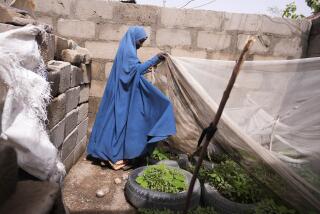A MOVIE FOR THE HUNGRY
KORR, Kenya — For three weeks, actors used to the good life--Ted Danson and Ally Sheedy among them--lived in the Kaisuti Desert near the border of Ethiopia and Sudan, sleeping in tents on a patch of parched earth. The temperature lingered at 105 degrees, sand and dirt blew constantly--and a shower was two buckets of water a day, even for big American stars.
Director Robert M. Young (“One Trick Pony,” “Short Eyes,” “Ballad of Gregorio Cortez,” “Extremities), as well as crew and remaining cast, likewise sacrificed amenities, if temporarily.
The cause: “We Are the Children,” an ABC movie about famine in Ethiopia with a fictional story line but harsh background. It just wrapped and is due for broadcast in December or January.
Conceived by Ellwood (Bud) Kieser, a Catholic priest and producer of what he calls “value-oriented programming” (like “Insight” for 23 years), the movie has been touted as an altogether altruistic project.
“We’re not in this for anything but raising consciousness and helping with famine relief,” said executive producer Kieser, whose Paulist Pictures promises to turn over any profit from the $2.9-million movie to relief.
Yet Kieser conceded that with budget overages “there may not be a profit”--and that all aspects of the production are not so charitable. For one thing, the network will be selling high-priced air time to advertisers just as it would with any other show.
“From their (network executives) viewpoint, this is a high-concept movie,” Kieser said, without apology. “I think this will be a very, very commercial movie.”
The budget was large for a TV movie, he said, “but shooting in Kenya (is difficult). This is a very ambitious production.” The budget accommodates high-priced talent that has worked for its going rate, according to Kieser, not for scale. And “back-end” deals are in the works for syndication, videocassette sales and foreign distribution--meaning probable profits down the line for companies that pick up the ancillary rights.
But the cast and production staff “would never have done this (film) if they didn’t care about world hunger,” Kieser said.
Even without profits earmarked for famine relief, Kieser believes the project is worthwhile if it can help re-ignite what would seem to be a waning national interest in starving Africans.
“Americans responded to the Ethiopian famine,” Kieser said, “but Americans are tired now. They are suffering compassion fatigue. I’d like to help the American people respond again.”
“We Are the Children,” written by Michael de Guzman, is about a recent medical school graduate (Sheedy) who goes to work in an African famine relief camp with idealistic notions about helping the starving people. She meets and falls in love with a free-lance journalist (Danson) and learns how to care and keep her sanity at the same time from an American nun (Judith Ivy) at the camp.
The impetus for the story came from Kieser’s trip to Ethiopia with actor Cliff Robertson in November and December of 1984 for Catholic Relief Services. Their footage of famine victims got wide play in the American media, and Kieser sold ABC on a movie about relief work.
Kieser had hoped to film the movie in Ethiopia, but the government there turned him down (“We portrayed guerrillas (in the script) and Ethiopia denies guerrillas exist,” Kieser said. “We also spoofed Marxism a bit”). He chose to shoot in this part of Kenya because both the people and the terrain are similar to what he found in Ethiopia. The flat landscape is a patchwork of browns, from reddish to light sandy. Even the mountains are brown, their rock faces wrinkled by the winds, sand and time.
Along with Young, the American actors and the British crew, Kieser arrived on this spot in late August, 240 miles due north of Nairobi, under a bright blue sky that showed not the slightest hint of rain. For more than three weeks, they lived on cots in green tents, read at night by kerosene lamp and went back and forth from the set in rattling, dusty trucks.
With 85% of production completed, the Ethiopian government complained to Kenya because the production was using Ethiopian flags and license plates. Not wanting to offend its neighbor, Kenya shut down production--at gunpoint. Kieser flew to Nairobi, talked with officials and filming resumed less than two days later.
Fifteen hundred local extras from the Samburu and Rendille tribes appear as famine victims. Their roles do not require much acting. The nomadic people, like so many people in Africa, live on the edge. They are not starving now, but a little less rain and they wouldn’t survive very long.
Plentiful rains this year have eased the famine in Ethiopia somewhat, but drought and malnutrition continue severe in other parts of the continent. In southern Sudan, for example, relief agencies say thousands are starving and a civil war has made it difficult--and for long periods impossible--for relief agencies to bring in food.
“The setting was certainly realistic,” Kieser said. “I could have had the same terrain in the Mohave Desert but not the people. Los Angeles has 10,000 Ethiopians, but they all eat at McDonald’s. This is real. I came here for the people.”
The Hollywood producers negotiated with the tribal chiefs and elders, as well as with the local missionary priests, to hire the local residents as extras. They paid “about 20% over the local going rate,” said Kieser, as much as a few dollars a day--”We’ve been very good for the economy of this area.”
The folks from Hollywood had a few things to learn about life in these parts. After a few days of filming from morning until late afternoon, the extras balked. The chiefs told the producers, as one producer later put it, “I don’t know about you wazungu (“white people” in Swahili), but we know better than to be out in the middle of the day in this heat.”
The biggest problem for the crew was not heat but the towering, twisting cylinders of soil and sand whipped up by the wind. Dust storms were so frequent that “I had to clean out my hearing aid every day,” Kieser said.
During the three weeks of filming, the actors were treated to two overnight trips to Nairobi, riding with the day’s rushes in a small plane that lifted off from the dirt landing strip here.
“I never had to work for this long in a place where I had to use a makeshift toilet,” Judith Ivy said. “You feel like a cat, shoveling dirt on top afterward. Every time I go to Nairobi, I flush the toilet--just to hear that sound.”
In one scene, Ivy, as the nun, gives the arriving doctor a primer on life in a refugee camp. The script mentioned wild animals, makeshift showers and unpotable water. Ivy improvised an extra warning that she had heard upon her arrival here: Always check the toilet seat for scorpions.
“Living with the people here has been a very eye-opening, and heart-opening, experience,” Sheedy said.
Pointing to Cecilia, a girl from the Rendille tribe who adopted Sheedy during the filming, the actress said: “I just love this little girl. She doesn’t speak English, and I don’t speak Rendille, yet I understand her perfectly.”
“We Are the Children” appealed to Ivy, she said, “because a certain part of me was feeling that I wasn’t participating in helping feed the starving, at least not in the sense that rock stars were giving. When this came up, it seemed like the actors’ way of contributing.”
“It seemed more interesting, more of an adventure than dressing up in pretty clothes to roll around in the sheets with some Hollywood actor,” she said, smiling through the mosquito netting in her dressing room, “although I’d take that right now.”
Mark Kawab, 38, a Rendille teacher, said the locals were grateful for the opportunity to earn some money. He said he thought the movie might spur people to give more food to Africa.
“Although they are not living in this area, people can see through this movie that people indeed need to be helped,” he said.
The temporary influx of these Westerners put money in the pockets of 1,500 people. Many of the children drank soda pop for the first time in their lives and even saw a movie, “Dumbo,” which the crew screened on their video equipment one night.
Kieser has also arranged financing for two of five classrooms desperately needed here--Paulist Productions paid for one, Sheedy and Young pooled their money for another and Kieser is still trying to raise the remainder.
Yet the producer-priest worries about what happens to the people here after the cameras leave. “A sudden influx of money can cause dislocation,” he said. “Those are tough questions and I don’t have easy answers.”
But he thinks a dramatic program on famine can help these tribes, and others who go hungry in Africa, by awakening viewers to the problem that still exists on the continent.
“I hope Americans who feel given out will find they have much deeper reserves of feeling,” he said. “I think God lives in these people and that’s what I hope (viewers) will see in this movie.”
More to Read
Only good movies
Get the Indie Focus newsletter, Mark Olsen's weekly guide to the world of cinema.
You may occasionally receive promotional content from the Los Angeles Times.











